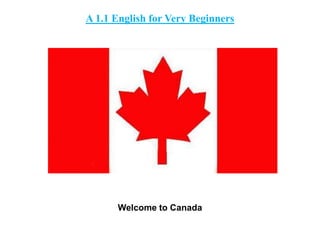
A 1.1 English For Very Beginners
- 1. A 1.1 English for Very Beginners Welcome to Canada
- 2. Learning Objectives • Greet someone and introduce yourself • Learn the alphabet • Spell your name and someone else’s name • Say which language you speak •Greet someone and introduce yourself Unit 1, Exercise 1 Hello. My name is Susan. Hello. My name is Susan. Hello. My name is Susan. What is yours? Hello. My name is Susan. What is yours? Oh, I see. Your name is Andrew. Oh, I see. Your name is Andrew? Andrew? How do you spell Andrew? Andrew? How do you spell Andrew? A N D R E W Andrew A N D R E W Andrew
- 3. A for Andrew J for James S for Simon B for Barbara K for Kevin T for Timothy C for Carol L for London U for Ulysses D for David M for Michael V for Victoria E for Edward N for Nelson W for William F for Francis O for Oslo X for Xavier G for George P for Patrick Y for Yvonne H for Henry Q for Quincy Z for Zachary I for Irene R for Robert Learn the English alphabet Unit 1, Exercise 2 The English alphabet A B C D E F G H I J K L M N O P Q R S T U V W X Y Z Unit 1, Exercise 3 The English Alphabet + Examples (Names)
- 4. Spell your name and someone’s name Unit 1, Exercise 4 Susan to Andrew: Your name is Andrew. Andrew to Susan: His name is Steve. Susan to Steve: Steve? How do you spell your name? Steve: S T E V E Susan to Steve: Thank you. Steve to Susan: You are welcome. Andrew to Susan: His name is Daniel. Susan to Daniel: Daniel? How do you spell your name? Daniel: D A N I E L Susan: Thank you. Daniel to Susan: You are welcome. Susan Andrew Steve Daniel
- 5. Practice by yourself Unit 1, Exercise 5 • Now, it is your turn. What is your name? How do you spell your name? • Look at the pictures and do the same What is his name? How do you spell his name? What is her name? How do you spell her name? What is his name? How do you spell his name?
- 6. What is her name? How do you spell her name? What is her name? How do you spell her name?
- 7. Subject Verb 1st person singular I am 2nd person singular you are 3rd person singular (masculine/feminin e) he/she is 1st person plural we are 2nd person plural you are 3rd person plural (masculine and feminine) they are Conjugation Verb: TO BE (Present Tense)
- 8. Grammar Possessive Adjectives: His name (3rd person singular when the possessor is a male) Her name (3rd person singular when the possessor is a female) Say which language you speak Unit 1, Exercise 6 My name is Susan. I speak English. My name is Susan. I speak English. Your name is Hans. You speak German. Your name is Hans. You speak German. Her name is Carol. She speaks French. Her name is Carol. She speaks French. His name is Luis. He speaks Spanish. His name is Luis. He speaks Spanish. Our names are Margarita and Marcello. We speak Italian. Our names are Margarita and Marcello. We speak Italian. Your names are Jan and Karel. You speak Dutch. Your names are Jan and Karel. You speak Dutch. Their names are Lota and Astrid. They speak Swedish. Their names are Lota and Astrid. They speak Swedish. Their names are Chi and Qiu. They speak Chinese. Their names are Chi and Qiu. They speak Chinese.
- 9. Practice by Yourself Unit 1, Exercise 7 Assignment 1 due for the 2nd Thursday of your course: Now, it is your turn. What is your name? Which language(s) do you speak? Introduce your family and say which language(s) they speak. Create a short video or a voki (www.voki.com) and send it to claudine@cdtranslationservices.com
- 10. Assignment 2: Post a message on the Discussion Board before the 3rd Thursday of your course before 11 p.m. Here are the instructions: •Introduce yourself •Spell your name •Say which language(s) you speak •Introduce the members of your family or your friends (You may decide to start with introducing one person and this person continues introducing himself/herself. You may decide to do the whole introduction yourself. Both options are possible). •Spell their names •Say which languages they speak
- 11. Assessment •For each assignment, accuracy is worth 5 marks, fluency 5 marks, interaction (in Assignment 2, you can play different roles) 5 marks and coherence 5 marks. •Each lesson (theory, practice and assignment) takes a maximum of two hours. Lesson Overview You used audio, video and written documents to learn how to speak English in some practical situations such as a cocktail party, a university registration office or a library. English is spoken, not shouted. With the time, you know where to stress the word. A part of this course focuses on pronunciation. So, please listen to the dialogues and practice, practice and practice to drill your ears. Lesson Summary You learnt how to introduce yourself and someone else, spell your name and other people’s names and say which language(s) you speak as well as which languages other people speak. In the next lesson, you talk about your citizenship, the place you live in, your profession and the people you know.
